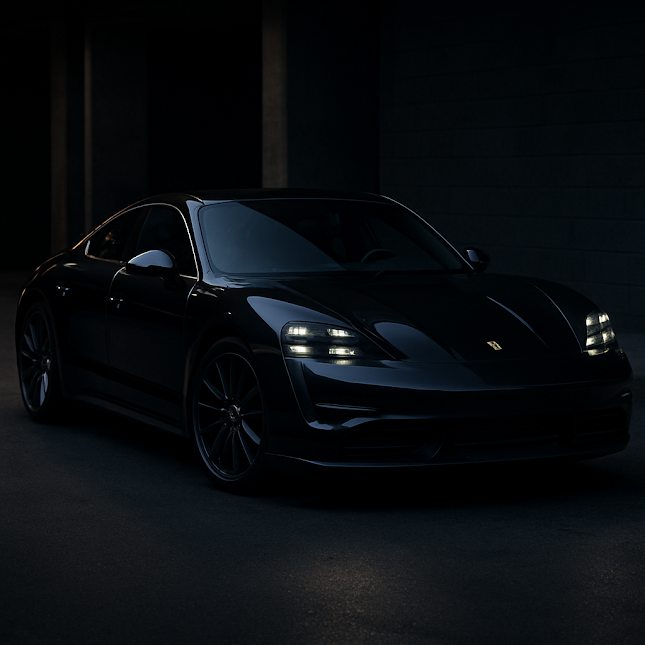Luxury car photography isn’t just about snapping a shiny vehicle under the sun. It’s a sophisticated blend of precision, lighting mastery, brand storytelling, and visual seduction. From Ferrari’s crimson fire to Rolls-Royce’s quiet luxury, each shot tells a tale of speed, craftsmanship, and prestige.
In this comprehensive guide by takenbyme.art, we dive into the techniques, settings, gear, and industry secrets behind photographing high-end cars for commercial, editorial, or private collectors' projects.
 |
| "A luxury car photographed under soft studio lighting with a cinematic aesthetic." |
Why Luxury Car Photography Matters
Luxury vehicles symbolize status, precision engineering, and aesthetic excellence. Whether it's a Porsche Carrera glistening at sunset or a Bugatti Chiron roaring under studio lights, luxury car images are central to branding, marketing, and social prestige.
From dealership websites to glossy magazines and influencer campaigns, high-impact automotive photography enhances desirability and increases conversions for brands and sellers alike.
Essential Gear for High-End Auto Shoots
Luxury car photography requires professional-grade tools to match the vehicle's level of craftsmanship:
Cameras:
-
Nikon Z9 – Mirrorless flagship for ultra-fast shutter and 8K video.
-
Leica SL2 – For timeless elegance and unmatched color science.
-
Canon EOS R5 – Known for high-resolution and fast autofocus.
Lenses:
-
70–200mm f/2.8 – Ideal for compressing backgrounds and details.
-
24–70mm f/2.8 – A flexible lens for wide and close-up compositions.
-
Prime 50mm f/1.2 – Perfect for capturing intricate design details and badges.
Explore more camera gear for luxury shoots.
Location Is Everything
The environment should complement the car's identity:
-
Urban luxury: Think glass high-rises, city lights, and reflections.
-
Desert solitude: A Rolls-Royce Wraith under Arizona’s sun is cinematic.
-
Private estates: Gated mansions with cobbled paths reflect exclusivity.
Photographers often scout GEO-targeted regions like Beverly Hills, Monaco, Dubai, or London, where luxury automotive culture is part of the landscape.
Lighting: Natural vs. Studio
Natural Light:
-
Shoot during the golden hour to reduce harsh reflections.
-
Use polarizing filters to eliminate windshield glare.
-
Avoid direct sunlight hitting reflective paint.
Studio Lighting:
-
Softboxes and light panels create even, controllable highlights.
-
Flagging tools help carve out contrast on reflective surfaces.
-
Use constant lighting setups to sculpt edges on hypercars.
For more on luxury lighting setups, visit our mirrorless photography section.
Framing and Composition
Luxury car photography demands thoughtful framing that elevates the design:
-
Low angles emphasize power and stature.
-
Detail shots on wheels, logos, and exhausts showcase craftsmanship.
-
Motion blur shots (using panning technique) evoke speed and control.
Pro tip: Use the rule of thirds and center on brand-defining elements like the grille or headlights.
Post-Processing: Creating That Million-Dollar Look
High-end auto photos go through intensive retouching to correct reflections, emphasize metallic finishes, and color grade for emotion.
Top tools include:
-
Adobe Photoshop – For removing distractions and compositing.
-
Lightroom Classic – Color toning and batch processing.
-
Capture One Pro – Ideal for commercial tethered shoots.
See our tips on photo editing for luxury visuals.
Luxury Car Photography Niches
-
Commercial Advertising: For dealership brochures and billboards.
-
Editorial: For magazines like GQ, TopGear, or Robb Report.
-
Social Media Influencers: Paid collaborations for brand lifestyle campaigns.
-
Collector Documentaries: Visual records for high-end car collectors or auction houses like Sotheby’s.
Case Study: Shooting a Lamborghini Aventador in Los Angeles
📍 Location: Downtown LA, night shoot.
📷 Camera: Sony A7R V with 24–70mm GM II.
💡 Setup: Three LED light panels and light painting tools.
🎨 Post: Clean plate editing, color grading with silver tones, highlight enhancement.
Result? A cinematic look resembling scenes from Fast & Furious with editorial elegance.
Licensing, Copyright, and Insurance
Don't overlook the business side:
-
Obtain model and property releases for commercial use.
-
License images for editorial vs. promotional differently.
-
Secure your shoots with photography insurance, especially when shooting multimillion-dollar vehicles.
Building a Portfolio That Converts
You need more than one good photo. A winning luxury auto portfolio includes:
-
Diverse lighting conditions
-
Multiple car brands (exotic, executive, classic)
-
Editorial spreads and behind-the-scenes
-
Storytelling through sets, models, and styling
Curate your best works on personal websites, Behance, or your TakenByMe gallery.
Tips from the Pros
“Photographing luxury cars is like photographing celebrities. Respect the curves, know their personality, and never over-edit.” – James Deakins, Auto Vogue Photographer
“Always shoot wide and crop later. You never want to miss a corner of a Ferrari.” – Michelle Grant, Canon USA Ambassador
Monetizing Luxury Car Photography
-
Commercial contracts with car brands or dealers.
-
Stock photo sales on luxury niche platforms.
-
YouTube and tutorial content on editing or BTS shoots.
-
NFT car art collections for digital luxury collectors.
Final Thoughts
Luxury car photography is a high-value niche combining fashion, engineering, lighting mastery, and business sense. If done right, it can open doors to exclusive gigs, brand partnerships, and international exposure.
Whether you're just starting or refining your brand, let each photograph be a tribute to elegance on four wheels.
➡️ Discover more visual artistry on TakenByMe.Art.
#LuxuryCarPhotography #ExoticCars #AutoVisuals #PhotographyTips #CarShoot #Supercars #TakenByMeArt #RollsRoyceStyle #EditorialPhotography #CarPhotographers
